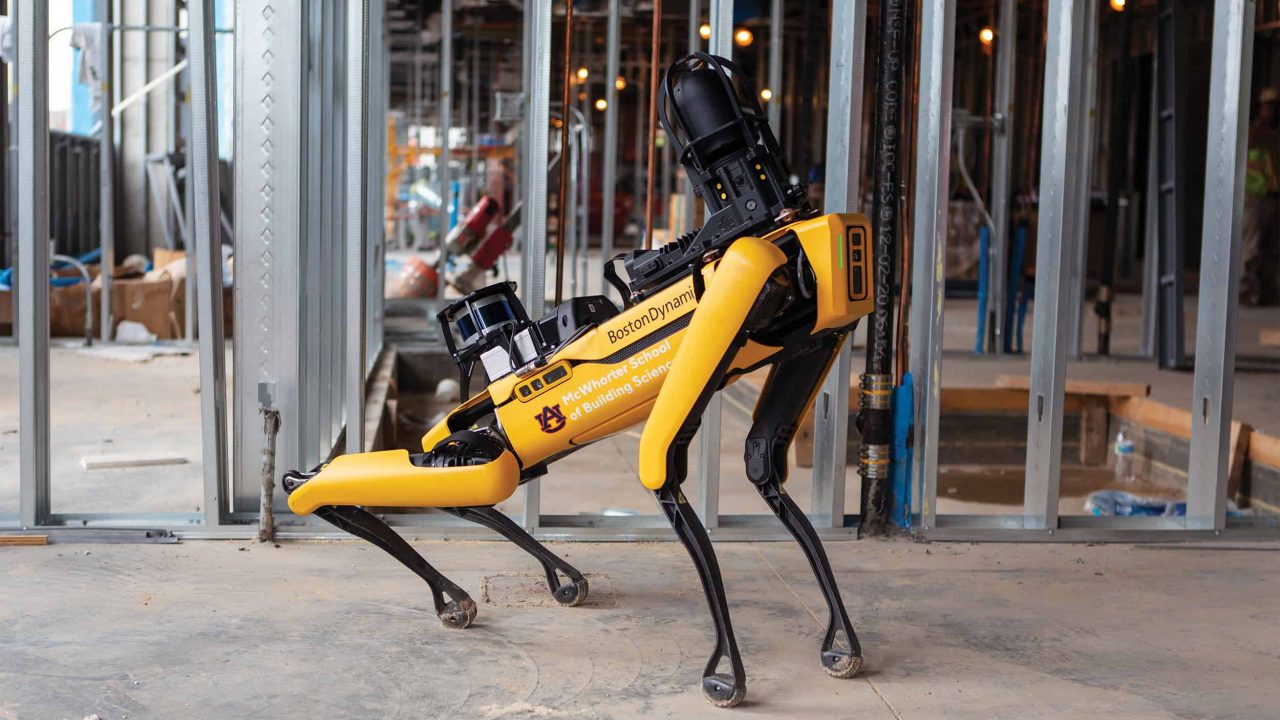Meet Mac the Robot Construction Dog

McWhorter School of Building Science faculty have an innovative new partner in construction research.
Nicknamed “Mac,” the four-legged robotic dog is a Boston Dynamics Spot. The robot is designed for data collection and is intended for use in a number of settings, such as construction and mining, where it can support inspections, exploration and site documentation and help ensure safety of workers. In the McWhorter School of Building Science, Mac will be used for research, teaching and outreach.
Different from many other market-available robots, Mac is able to readily navigate construction sites, climb over debris, walk up and down stairs, avoid unexpected obstacles, get back up if knocked over and is water resistant—all ideal qualities for working in the rough and challenging construction environment. What really sets Mac apart is the ability to perform missions autonomously. Once programmed, Mac will travel to the designated locations—avoiding people and obstacles along the way—take scans or photos, known as “actions,” and then return, all without the need for human intervention. Mac can take scans using LiDAR, a pan/tilt/zoom camera, a 360-degree camera, thermal imaging and more.
According to Dr. Wetzel, “As researchers, Mac is a mechanism to explore solutions to specific labor and data collection inefficiencies in our industry. Using the tech that we have in Mac opens the door to solving current market issues but also gives us a benchmark for the next steps. We are always asking ourselves, how can we take the current tech and push it forward for additional application?”
Called “Mac” in honor of Earlon McWhorter for whom the McWhorter School of Building Science is named, Mac is a powerful addition to the school’s suite of tools. Mac is being used to support faculty and graduate student research and will also be introduced to students in class. As more construction companies are using robots, exposure to these technologies will better prepare students to engage with them in the field.
About Mac’s role in the classroom, Wetzel said, “Outside of research, Mac plays a huge role within the McWhorter School of Building Science. In teaching, Mac is representative of a big shift in our industry to apply advanced technologies, including robotics. Current market robots can lay brick (SAM), tie rebar (Tybot), finish drywall (Canvas) and layout walls (Dusty Robotics), among a whole host of other scopes. In today’s industry, knowledge and technology are not mutually exclusive; the two are inextricably linked. We teach a lot of technology in our curriculum and robotics is the next obvious step.”
One way Mac’s “handler,” Assistant Professor Eric Wetzel, has been using the robot in his research is to conduct a comparative analysis of how well Mac performs compared to a human in capturing construction site data through LiDAR on an active construction project. Along with his coauthors, Tom Leathem and Junshan Liu, the research team is evaluating the productivity, quality and accuracy of a robot-based scan in comparison to a tripod-mounted, human-controlled scan. If Mac can reliably perform that data capture function as well as a human, it could allow a project’s field engineer, the person historically responsible for site data capture, to concentrate efforts elsewhere.
Related Stories:
Auburn University’s robotic dog advancing research, teaching, outreach as part of cutting-edge construction technology evolution
Related people:
Eric Wetzel,
Tom Leathem,
Junshan Liu